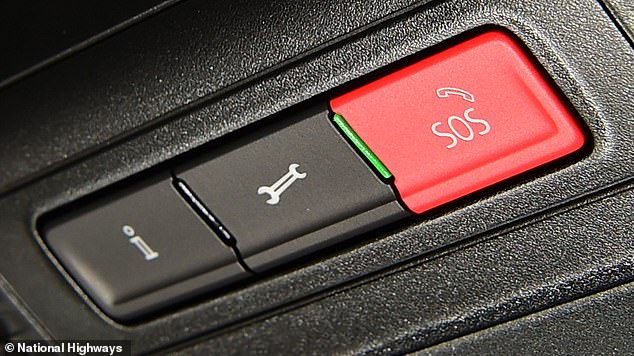Thousands of drivers are wasting emergency services operators valuable time every year by accidentally dialling 999 using a feature installed in their cars, according to a new report.
Some 350,000 calls have been made to the emergency services line from vehicles since April 2018, though two-thirds were false alarms, a new investigation has revealed.
Charity the RAC Foundation, which commissioned the study, said motorists are frequently triggering ‘eCall’ activations from their vehicles in error.
The eCall feature automatically rings 999 and provides the emergency services with information such as the vehicle type and location under the assumption that the driver is in distress or has been involved in a collision so that help can arrive as quickly as possible.
The system will spontaneously ring the emergency services when the airbags deploy in a crash or can be manually instigated by pressing a button often labelled ‘SOS’ on the dashboard.
It has been a legal requirement for cars and vans sold in the UK to have the system installed since April 2018, though the charity says that motorists are making thousands of calls in error because they are ‘unfamiliar’ with the SOS button.

Some 350,000 calls have been made to the emergency services line from vehicles since April 2018, though two-thirds were false alarms, a new investigation has revealed
Transport expert Dr Nick Reed, who conducted the study for the RAC Foundation, found that more than 85 per cent of eCall alerts made last year were triggered manually using the SOS button.
‘About three-quarters of those were false alarms’, according to the research.
This is compared with approximately one in three automatic calls.
Taken together, about two-thirds of all calls last year were by mistake, the study concluded.
The report found common causes of manual false alarms include ‘button misuse, poor interface design, system faults and demonstration presses at dealerships’.
Read More
EXCLUSIVE The 10 most shocking dash cam crashes and dangerous driving incidents caught on camera in the past year

Dr Reed listed several high-profile incidents where a significant difference is likely to have been made if eCall was available.
One was the Selby train crash of 2001 which left 10 people dead when a Land Rover careered off the M62 motorway in North Yorkshire and came to a standstill on train tracks.
A train derailed when it struck the vehicle, and then a second train hit the first.
The report stated that eCall could provide emergency services with ‘better information more quickly’ when a vehicle breaks down in a live lane on a smart motorway without a hard shoulder, compared with stopped vehicle detection systems, which rely on radar technology.
The author recommended that more of the information provided by eCall should be passed on to road management organisations such as National Highways.
He also warned that owners of up to four million cars and vans fitted with early versions of eCall could find themselves with systems with do not work because they rely on 2G and 3G mobile phone networks, which are progressively being deactivated.

Vehicle makers install the eCall SOS button in different locations in the cabin. It is often found in the ceiling console by the internal rear-view mirror, behind a pop-out hatch or on the centre console
Drivers and passengers do not need to be carrying a mobile phone for the built-in safety feature to work.
Vehicle makers install the eCall SOS button in different locations in the cabin.
It is often found in the ceiling console by the internal rear-view mirror, behind a pop-out hatch or on the centre console.
Drivers should refer to their car owner’s manual if they are unaware of its position.
National Highways points out that there is ‘no need to check if your eCall is working, as the system will carry out a self-test each time the vehicle is started’.
Motorists pressing the button to ensure it is working is one of the contributors to the high volume of false activations identified by RAC Foundation’s investigation.

The RAC Foundation report found common causes of manual false alarms include SOS button misuse, poor interface design, system faults and demonstration presses at dealerships
Read More
Britain’s worst drink driver had enough alcohol in his system to have put him in a COMA

Steve Gooding, director of the road safety charity, said eCall is ‘a great idea’ and can be ‘particularly useful in remote areas where no other road users are on hand to dial 999’.
He went on: ‘However, this report reveals a number of shortcomings in the system that need sorting, not least in the processes through which data is handled and the system’s historical reliance on old mobile phone networks that are being turned off.
‘This requires urgent attention otherwise lives could be at risk from life-saving technology failing when it’s needed most.
‘The number of manually triggered false alarms also suggests the need for action to explain what is clearly still an unfamiliar system for many drivers.’
Dr Reed said: ‘The case for accelerating the emergency response to road crashes through the eCall alert system is clear.
‘The report highlights that its effectiveness is being undermined by challenges in exploiting the data it provides and by a high rate of false alerts, often triggered by accidental misuse.
‘As an ever-increasing proportion of vehicles are equipped with eCall and similar functionalities become available via smartphones, smartwatches and dashcams, it is essential that we assess the true value of these technologies and ensure we unlock their full, life-saving potential.’

